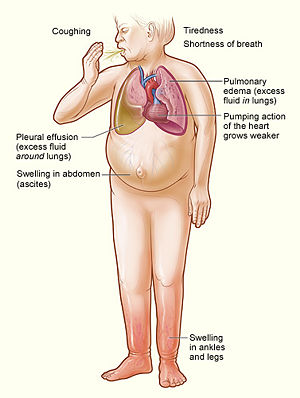Chronic heart failure: Difference between revisions
Kingrajinix (talk | contribs) |
|||
| Line 22: | Line 22: | ||
===Clinical Features=== | ===Clinical Features=== | ||
The [[#Definition|definitive]] features of heart failure are '''breathlessness''' or '''exhaustion on less than normal exertion ''OR'' at rest'''. Reduced heart function and associated changes in other organ systems are also used in the definition.<br><br> | The [[#Definition|definitive]] features of heart failure are '''breathlessness''' or '''exhaustion on less than normal exertion ''OR'' at rest'''. Reduced heart function and associated changes in other organ systems are also used in the definition.<br><br> | ||
Many of the common symptoms of heart failure are due to fluid overload. As the left ventricle stops being able to pump blood around as efficiently, ''fluid'' in the cardiovascular system ''backs up'' and ends up ''in the lungs'' causing: | Many of the common symptoms of heart failure are due to fluid overload. | ||
====Left Heart Failure==== | |||
As the left ventricle stops being able to pump blood around as efficiently, ''fluid'' in the cardiovascular system ''backs up'' and ends up ''in the lungs'' causing: | |||
*orthopnoea (breathlessness on lying down) | *orthopnoea (breathlessness on lying down) | ||
*paroxysmal nocturnal dyspnoea | *paroxysmal nocturnal dyspnoea | ||
**acute orthopnoea waking somebody from sleep. Patients usually say they wake up gasping for breath. | **acute orthopnoea waking somebody from sleep. Patients usually say they wake up gasping for breath. | ||
*bibasal crackles in the lungs | |||
====Right Heart Failure==== | |||
When the right ventricle fails, fluid backs up ''in the interstitial fluid'' causing: | |||
*ankle swelling | *ankle swelling | ||
*raised [[JVP]] | |||
*raised [[JVP]] | |||
*hepatomegaly | *hepatomegaly | ||
*ascites | *ascites | ||
====Congestive Cardiac Failure==== | |||
This is where features of '''both left and right''' heart failure are present. | |||
Less commmon features of heart failure: pulse abnormalities; tachycardia; pulsus alternans (alternating strong and weak pulse); and reduced pulse volume. | |||
===Investigations=== | ===Investigations=== | ||
Latest revision as of 20:32, 8 August 2011
Definition
This condition is a syndrome rather than a single pathological process. The definitive features of heart failure are breathlessness or exhaustion EITHER on less than normal exertion OR at rest.
Epidemiology
Pathophysiology
Two-thirds of heart failure is caused by coronary heart disease (i.e. myocardial infarction) with the rest being caused by hypertension, arrhythmias or valvular disease. Congenital heart defects may also cause heart failure but these are much rarer. Something has to make it harder for the heart to work which, when looking at it from a physics point-of-view means a reduction in cardiac output. Remember:
Anything which reduces either stroke volume, heart rate or increases peripheral resistance (which all consequently reduce cardiac output) makes the heart work harder and can when severe enough cause heart failure. There are a variety of causes which effect each criterion:
- Reduction in stroke volume
- Myocardial infarction - by far the most common. Killing heart muscle makes the heart less efficient, reducing stroke volume.
- Valvular disease - Regurgitation means that a great proportion of it is either going the wrong way or dropping back into the chamber it was pumped from. De facto, this reduces stroke volume.
- Reduction in heart rate
- Arrhythmias
- Increase in peripheral resistance
- Hypertension - a high diastolic blood pressure (pressure of blood in the aorta when the left ventricle is filling) increases peripheral resistance, forcing the heart to either reduce stroke volume or work harder (resulting in ventricular hypertrophy)
Risk Factors
Have a look at the list of causes above. You'll get the idea for risk factors.
Clinical Features
The definitive features of heart failure are breathlessness or exhaustion on less than normal exertion OR at rest. Reduced heart function and associated changes in other organ systems are also used in the definition.
Many of the common symptoms of heart failure are due to fluid overload.
Left Heart Failure
As the left ventricle stops being able to pump blood around as efficiently, fluid in the cardiovascular system backs up and ends up in the lungs causing:
- orthopnoea (breathlessness on lying down)
- paroxysmal nocturnal dyspnoea
- acute orthopnoea waking somebody from sleep. Patients usually say they wake up gasping for breath.
- bibasal crackles in the lungs
Right Heart Failure
When the right ventricle fails, fluid backs up in the interstitial fluid causing:
- ankle swelling
- raised JVP
- hepatomegaly
- ascites
Congestive Cardiac Failure
This is where features of both left and right heart failure are present.
Less commmon features of heart failure: pulse abnormalities; tachycardia; pulsus alternans (alternating strong and weak pulse); and reduced pulse volume.
Investigations
Imaging
This is slightly more important that bloods in heart failure as it can determine the extent of the damage much more easily
- CXR - enlarged heart, visible lung hila
- ECG -
- Echocardiography - will show myocardial dysfunction, valvular disease, peridcardial disease
Bloods
- FBC - anaemia
- U&Es - renal function, electrolyte disturbance
- TFTs - thyrotoxicosis (can cause arrhythmias)
- LFTs - to exclude liver failure which can cause oedema
Management
The management of heart failure basically involves the follwing drugs:
- Diuretics and ACE inhibitors to reduce the fluid load on the heart.
- Beta blockers to make it work less hard (and calcium channel blockers in some situations).
- Spironolactone
- Other vasodilators (e.g. nitrates like isosorbide mononitrate)
- Digoxin - benefit debatable
